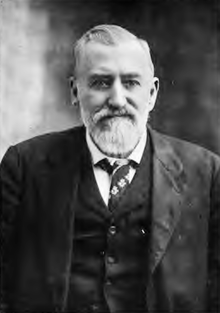William Packwood
William Henderson Packwood (October 23, 1832 – September 21, 1917) was an American politician who served at the Oregon Constitutional Convention in 1857. A United States Army veteran from the state of Illinois, he was also a school superintendent and acquaintance of President Abraham Lincoln. He was an early resident of Baker City in Eastern Oregon.
William Packwood | |
|---|---|
 | |
| Member of the Oregon Constitutional Convention | |
| In office 1857–1857 | |
| Constituency | Curry County |
| Personal details | |
| Born | William Henderson Packwood October 23, 1832 Mount Vernon, Illinois |
| Died | September 21, 1917 (aged 84) Baker City, Oregon |
| Spouse(s) | Johanna A. O'Brien |
Early life
William Packwood was born near the community of Mount Vernon, Illinois, to Larkin Canada Packwood and Elizabeth Cathcart on October 23, 1832.[1] Packwood received two years of formal education and later moved to Springfield, Illinois where he knew future United States President Abraham Lincoln.[1] In 1848 he enlisted in the U.S. Army with Company B of the U.S. Mounted Rifles.[1] The following year Packwood and the company were sent to the newly created Oregon Territory and stationed at Fort Vancouver.[1]
Oregon
Packwood went to California when gold was discovered there, returning to Oregon in 1851 where he was transferred to Port Orford, Oregon to fight Native American uprisings.[1] In 1853 he was discharged from the Army and became a gold miner for several years.[1]
In 1854, he served as a lieutenant for a vigilante group called the Coos County Volunteers. In that role, he helped lead a massacre of the Nasomah band of the Coquille Indian Tribe. The Volunteers attacked while the Nasomah people were sleeping, killing between 15 and 21 people. [2]
In 1855, Packwood served as captain of the Coquille Guards during the Rogue River Wars against Native Americans in Southern Oregon.[1] In 1857, he represented Curry County in southwestern Oregon at the Oregon Constitutional Convention that met in Salem during August and September, and framed a constitution in anticipation of Oregon becoming a state.[3] He was the youngest of the delegates at the convention.[4]
Packwood then moved east of the Cascade Mountains to Eastern Oregon where he was involved with establishing the town of Auburn in 1862.[1] Auburn was a gold-mining boomtown that was briefly the county seat of Baker County, and Packwood helped plat the town.[5] There he served as the first school superintendent of Baker County in 1862.[1] During the 1864 presidential election he campaigned for Abraham Lincoln in that county.[1] Soon after, he was responsible for another Baker County town receiving the name of Sparta.[6] In that town he and his family built and operated a boarding house until 1867.[6]
Later life and family
In later years Packwood mined, was an assistant postmaster, clerk for Baker City, and a police judge before retiring in 1910.[1] In 1862, Packwood married Johanna A. O'Brien, with whom he would father five children.[1] He is the great-grandfather of former United States Senator Robert Packwood.[4][7] William Henderson Packwood died on September 21, 1917, in Baker City[1] with interment at Mount Hope Cemetery.[7] He was the last living member of the constitutional convention at his death.[1]
References
- Corning, Howard M. (1989). Dictionary of Oregon History. Binfords & Mort Publishing. p. 190.
- Younker, Jason. "Nasomah Massacre of 1854". The Oregon Encyclopedia. Portland State University. Retrieved 2016-06-12.
- Crafting the Oregon Constitution: About the Convention Delegates Oregon State Archives. Retrieved on June 20, 2016.
- Dielman, Gary. "William Packwood (1832-1917)". The Oregon Encyclopedia. Portland State University. Retrieved 2014-06-23.
- City of Auburn. bakercounty.net. Retrieved on March 2, 2008.
- City of Sparta. bakercounty.net. Retrieved on March 2, 2008.
- Baker County Oregon. The Political Graveyard. Retrieved on March 2, 2008.
External links
- Photograph of Sparta, Oregon
- Biographical Sketch of William Packwood at Oregon State Archives
- Lockley, Fred (1 Mar 1915). "Reminiscences of William H. Packwood". The Quarterly of the Oregon Historical Society. 16. Retrieved 12 April 2013.